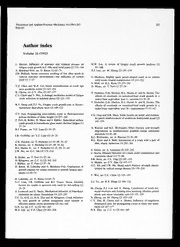
Theoretical and Applied Fracture Mechanics 1991: Vol 16 Index PDF
Preview Theoretical and Applied Fracture Mechanics 1991: Vol 16 Index
Theoretical and Applied Fracture Mechanics 16 (1991) 263 Elsevier Author index Volume 16 (1991) L. Bertini, Influence of seawater and residual stresses on H.W. Liu, A review of fatigue crack growth analyses (2) fatigue crack growth in C—Mn steel weld joints (2) 135-144 91-108 A. Briickner-Foit, see D. Kwon (1) 63-71 Z.J. Luo, see M. Zheng (2) 155-159 J.H. Bulloch, Stress corrosion cracking of low alloy steels in natural seawater environment—the influence of carbon E. Madenci, Slightly open, penny-shaped crack in an infinite level (1) 1-17 solid under biaxial compression (3) 215-222 S. Mall, see R.L. Ryan (3) 255-261 Y.Z. Chen and W.Z. Lin, Stress intensification at crack tips D. Munz, see T. Fett (1) 27-34 near parabolic notch (3) 243-254 R. Chona, see C.Y. Zhu (2) 167-177 T. Nicholas, G.K. Haritos, R.L. Hastie Jr. and K. Harms, The C.L. Chow and Y. Wei, A damage mechanics model of fatigue effects of overloads on sustained-load crack growth in a crack initiation in notched plates (2) 123-133 nickel-base superalloy: part I—analysis (1) 35—49 T. Nicholas, G.K. Haritos, R.L. Hastie Jr. and K. Harms, The R.Y. Deng and Z.J. Ye, Fatigue crack growth rate in ferrite— effects of overloads on sustained-load crack growth in a martensite dual-phase steel (2) 109-122 nickel-base superalloy: part II—experiments (1) 51-62 T.Y. Fan, Propagating semi-infinite crack in fluid-saturated C.L. Ong and S.B. Shen, Some results on metal and compos- porous medium of finite height (3) 237-242 ite patch reinforcement of aluminum honeycomb panel (2) T. Fett, K. Keller, D. Munz and J. Kubler, Subcritical surface 145-153 crack growth in borosilicate glass under thermal fatigue (1) 27-34 A. Razvan and K.L. Reifsnider, Fiber fracture and strength R.I. Fraser, see Y.C. Lam (1) 19-25 degradation in unidirectional graphite /epoxy composite materials (1) 81-89 J.R. Griffiths, see Y.C. Lam (1) 19-25 K.L. Reifsnider, see A. Razvan (1) 81-89 R.L. Ryan and S. Mall, Interaction of a crack with a pair of G.K. Haritos, see T. Nicholas (1) 35-49, 51-62 thin, elastic inclusions (3) 255-261 K. Harms, see T. Nicholas (1) 35-49, 51-62 R.L. Hastie Jr., see T. Nicholas (1) 35—49, 51-62 E. Sacco, see A. Leonardi (3) 223-235 J.W. Ho, see G.C. Sih (3) 179-214 C. Scavia, Dilatant behavior of a crack under compression and transverse shear (1) 73-80 K. Keller, see T. Fett (1) 27-34 S.B. Shen, see C.L. Ong (2) 145-153 H. Kitagawa, see C.C. Li (2) 161-165 A. Shukla, see C.Y. Zhu (2) 167-177 J. Kiibler, see T. Fett (1) 27-34 G.C. Sih and J.W. Ho, Sharp notch fracture strength charac- D. Kwon, H. Lahodny and A. Brickner-Foit, Limitations of terized by critical energy density (3) 179-214 growth regimes for cracks initiated in smooth fatigue spec- imens (1) 63-71 Y. Wei, see C.L. Chow (2) 123-133 H. Lahodny, see D. Kwon (1) 63-71 Y.C. Lam, J.R. Griffiths and R.I. Fraser, Stress intensity Z.J. Ye, see R.Y. Deng (2) 109-122 factors for cracks in grooved rolls used for hot-rolling (1) 19-25 M. Zheng, Z.J. Luo and X. Zheng, Correlation of notch bar, A. Leonardi and E. Sacco, Mechanical behavior of bimodular metal overturn and forming data involving effective plastic laminates on elastic foundation (3) 223-235 strain and stress triaxiality ratio (2) 155-159 C.C. Li, G.X. Li, H.X. Zhu and H. Kitagawa, Crack initiation X. Zheng, see M. Zheng (2) 155-159 by void growth in carbon manganese steel related to C.Y. Zhu, R. Chona and A. Shukla, Influence of singularity effective plastic strain increment (2) 161-165 dominated zone for propagating cracks in finite size speci- G.X. Li, see C.C. Li (2) 161-165 mens (2) 167-177 W.Z. Lin, see Y.Z. Chen (3) 243-254 H.X. Zhu, see C.C. Li (2) 161-165
